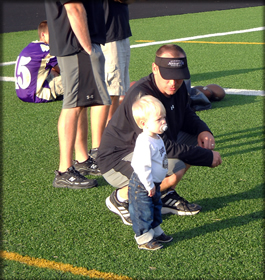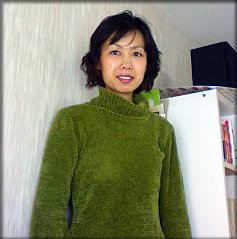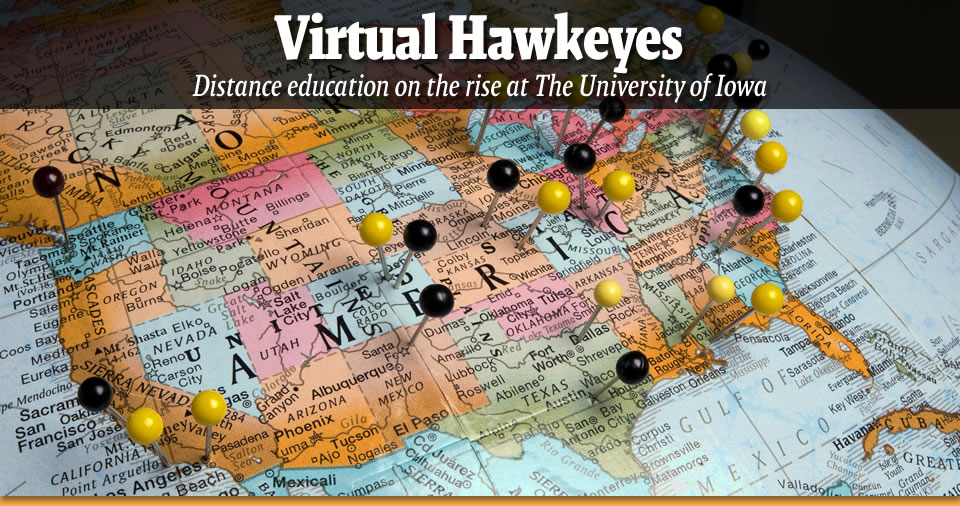-
Page Navigation Links:
- Skip to Site Navigation Links
- Skip to Features

- The University of Iowa
- Spectator
- Monthly News for UI Alumni and Friends

Rod Wiebers and his son, Eli, Waukee, Iowa

Alexandru Coman, Cluj-Napoca, Romania
© Greg Gray

Akiko Hagiwara, Tokyo, Japan
No matter where you live, you can be a true Hawkeye.
Just ask 29-year-old teacher Rod Wiebers of Waukee, Iowa, who is taking online classes to advance his career in the field of education. His goal is to earn an advanced degree required for licensure as a principal.
By pursuing distance education through the UI College of Education, Wiebers says he can teach and coach at Johnson High School, spend time with his wife, Joy, and still be home to tuck in his 16-month-old son, Eli, every night.
“I have the flexibility to take classes at my workplace if I have to stay at work longer, I can take them from the comfort of home, and I don’t have to worry about traveling in snowy Iowa winters to get to class,” says Wiebers, who is currently taking a special education clinical course.
Wiebers is one of a growing number of UI students—6,820 students in the 2008–09 academic year—who are “distance learners,” pursuing degrees or taking classes online from their own homes and communities, whether in Iowa or halfway around the globe.
“I wanted to pursue a degree in educational administration and looked at my options and The University of Iowa and the distance education program were a perfect fit,” says Wiebers, who hopes to either become a principal or an athletic director.
Iowa’s reputation as a Big Ten Research I university with highly ranked programs was another draw for Wiebers.
“The University of Iowa is a place with outstanding faculty members, curriculum, and instruction that is now being presented in a way that can meet the demands and issues of this era,” Wiebers says.
Distance learners are a diverse group, according to Chet Rzonca, associate provost and dean of the UI Division of Continuing Education.
Students enrolled in distance education complete course work in a variety of formats including web-based, off-campus extension, Guided Independent Study, and blended classes, which may combine elements of different formats.
He adds that distance or online education is a growing trend nationwide, especially for nontraditional students, for reasons that include rising gas prices and transportation costs, shortage of time, and the need for flexible schedules.
“Overall, the growth is due to peoples’ busy lives,” Rzonca says.
Other growing segments of online learners include those with disabilities and veterans. In fact, Rzonca says that distance learning is available to those who are stationed overseas in the military so they can serve their country and continue their educations.
Of the 6,820 students, 3,140 are students admitted to programs in the College of Liberal Arts and Sciences, followed by 1,464 in the Graduate College, 1,141 in the School of Management in the Tippie College of Business, 519 in the Tippie College of Business, 312 in the College of Nursing, and 126 in the College of Engineering. The remaining numbers represent the Colleges of Medicine, Pharmacy, Public Health, Law, and Dentistry.
Distance education is especially important in helping to replenish professions that nationally and in Iowa are experiencing a shortage, including high school principals and nurses, Rzonca says.
While some students are pursuing degrees online, others like Alexandru Coman, a physician from Romania, are taking one or two classes to enrich their knowledge base or to foster international research, teaching, and learning.
Coman, who is currently working as a researcher at the Center for Health Policy and Public Health, Institute for Social Research at Babes Bolyai University in Cluj-Napoca, Romania, has taken a global environmental health course online at Iowa. He did this after spending a semester in 2004 as a Fogarty Scholar at The University of Iowa.
“As soon as I heard about the possibility to take distance classes, I decided to participate,” Coman says. “I was exposed to the distance education experience while taking Infectious Diseases Epidemiology in Iowa. Some of my classmates were located in different classrooms and took the same course with me via a video conference system.”
Coman says the virtual class at Iowa was critical to being able to pursue a specialty in epidemiology.
“Through distance education you have access to the best specialists in a field,” Coman says. “It’s the next best thing after actually being in class, but with the added advantage of being able to network with specialists from around the world.”
Coman continues to collaborate in the field of infectious diseases epidemiology with Gregory Gray, professor of epidemiology in the UI College of Public Health.
“Distance education can help overcome barriers such as funds, distance, time, and lack of expertise,” Coman says.
Akiko Hagiwara of Tokyo, Japan, is taking a statistics course while she finishes her dissertation for a doctoral degree in second language acquisition. Although Hagiwara was able to finish most of her course work at Iowa, she needed to return to Tokyo to care for her ill mother.
“My dissertation is highly quantitative, and I always felt I needed to improve my knowledge of statistics,” says Hagiwara. “So, taking a distance education course is my ideal choice.”
This enables her to work on her dissertation six hours a day, care for her mother, do household chores for her, and take the Selected Applications of Statistics course.
Rzonca says the goal is not to recreate every program online that exists at the University. Instead, he emphasizes, they are looking at where Iowa can meet specific needs based on existing faculty expertise.
“All distance education programs offer a comparable experience with regard to quality and instruction,” Rzonca says.
Wiebers couldn’t agree more.
“I am constantly talking to others about how I’m going to be a graduate of The University of Iowa and forever a Hawkeye, and this is because I identify myself as a fan, student, and part of the school even though I’m miles away,” Wiebers says. “The faculty genuinely care about my progress as a student and person and are willing to help out in any way possible. I am very proud to be a member of The University of Iowa.”
—Lois J. Gray
with photo illustration by Kirk Murray
© The University of Iowa 2009
